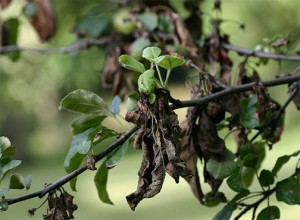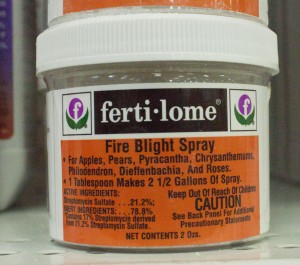FIRE! FIRE! FIRE BLIGHT!
FIRE! FIRE! FIRE BLIGHT!
Did your pears or apples look like they had been in a fire last spring? Were the leaves all scorched and black? If so, you got hit by fire blight. Read on for tips on how to control it.
PROBLEM: Fire blight is caused by a bacterium, and is a common and destructive disease of pears, apples, quince, crabapple and pyracantha. It occasionally attacks hawthorn, spirea, cotoneaster, photinia, amelanchier, and other related plants. It can destroy limbs and even entire shrubs and trees.
Disease symptoms can appear as soon as trees begin active growth. The first sign is a watery ooze from cankers on the tree bark. It will turn dark after exposure to air. Flowers are usually infected first, wilting and turning black or brown. Blight infections can move into twigs and branches from infected blossoms, causing stems and shoots to wilt. Eventually this turns black. Dead blackened leaves and fruit cling to branches throughout the season, giving the tree a scorched appearance.
Fire blight overwinters, and starts to spread with the onset of warm weather in the spring. The more vigorous and healthy a tree is, the more it can withstand a fire blight infection.
CONTROL: Fire blight is influenced primarily by seasonal weather. Warm spring temps, combined with rain, are ideal for disease development. Trees should not be irrigated while in bloom, if it all possible. Monitor trees regularly, and remove and destroy fire blight infections. If fire blight has been a problem in the past, spraying will prevent new infections, but will not eliminate wood infections; these must be pruned out. The easiest way to avoid fire blight is to plant varieties that are resistant or less prone to fire blight. If you choose to spray, we recommend ferti-lome Fire Blight Spray (streptomycin). Your first spray should be at the start of blossoming. Spray every 3-4 days during bloom time. If weather conditions favor the spread of fire blight, continue spraying at 5-7 day intervals. Do not apply streptomycin when fruit is visible on the plant.
Pruning out diseased branches is a must to help eliminate fire blight. Be sure to dip or spray your pruning tool before each cut with a 10% solution of bleach.











